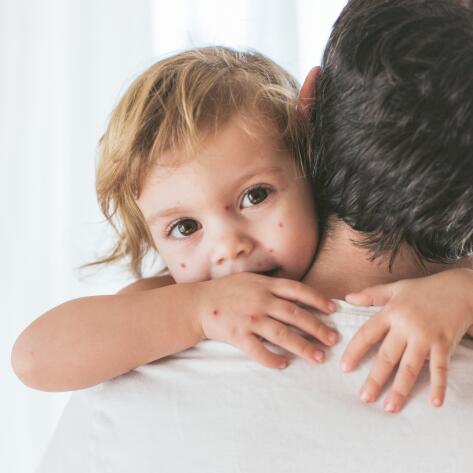How do you recognize and treat chickenpox?
How do you recognize and treat chickenpox?

The basics of chickenpox and its spots
Chickenpox is a benign but highly contagious disease caused by the varicella-zoster virus. In 90% of cases, it occurs between the ages of 3 months and 10 years old. After an incubation period of 1 to 2 weeks, the first symptoms are not very significant. After a few days, they become VERY recognizable: small spots appear that are very itchy. It usually takes 10-12 days to heal. Chickenpox itself cannot be cured, but there are ways to ease the discomfort and help your child through this difficult time.
Chickenpox scars are far from harmless, especially when they are in more visible areas like the face. Therefore, blisters and lesions from scratching must be treated carefully to avoid the risk of secondary infection that causes marks.
How to identify chickenpox
Your child is tired and grumpy and they’re speckled with small spots... Could that be it, chickenpox? It starts with small red spots that often appear first on the chest or neck and then spread to the whole body. They then turn into tiny fluid-filled blisters that usually dry out within 48 hours, forming a reddish-black scab. Beware: when the scab is scratched off, this is when there's a risk of scarring.
Treating chickenpox
- Clean the skin (without rubbing) with an antiseptic product prescribed by your doctor or advised by your pharmacist.
- Dry blisters with a drying formula to speed up repair.
- Repair dried out blisters with a suitable skin care product to avoid leaving marks.

Chickenpox: Is there anything to avoid?
Yes!
FRIENDLY (AND EXPERT) ADVICE TO LIMIT CHICKENPOX SCARS
Help! I’m itchy!
The skin is itchy. Really itchy... TOO itchy. Beware - a scratched chickenpox blister can leave a scar for life. Here are our tips and tricks to help your child find relief and limit scratching.
- First, use an antiseptic on the spots.
- Cut your child’s nails short to limit scratching lesions and secondary infection.
- Have your child wash their hands regularly.
- Give your child very short baths or showers with lukewarm water once or twice a day with a liquid dermatological soap.
- Protect the skin from perspiration as much as possible: it makes itching worse.
- Choose loose-fitting clothes that don’t rub against the skin.
OUR SOLUTIONS TO RESTORE YOUR SKIN
The essentials for restoring, soothing and purifying sensitive, fragilized skin for the whole family.
- Restorative Protective Cream
Best Seller
Cicalfate
Restorative Protective CreamSoothes - Restores - Purifies - Hand Restorative barrier cream
Cicalfate
Hand Restorative barrier creamHydrates - Protects - Restores
NEWSLETTER
We're always here for your skin!
All our tips on how to take care of your skin every day.

Which skin care routine should you adopt?
Identify what it really needs with the help of our experts and discover the most suitable skin care routine for you.




